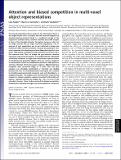Attention and Biased Competition in Multi-voxel Object Representations
Author(s)
Reddy, Leila; Kanwisher, Nancy; VanRullen, Rufin
DownloadKanwisher-2009-Attention and Biased.pdf (999.9Kb)
PUBLISHER_POLICY
Publisher Policy
Article is made available in accordance with the publisher's policy and may be subject to US copyright law. Please refer to the publisher's site for terms of use.
Terms of use
Metadata
Show full item recordAbstract
The biased-competition theory accounts for attentional effects at the single-neuron level: It predicts that the neuronal response to simultaneously-presented stimuli is a weighted average of the response to isolated stimuli, and that attention biases the weights in favor of the attended stimulus. Perception, however, relies not on single neurons but on larger neuronal populations. The responses of such populations are in part reflected in large-scale multivoxel fMRI activation patterns. Because the pooling of neuronal responses into blood-oxygen-level-dependent signals is nonlinear, fMRI effects of attention need not mirror those observed at the neuronal level. Thus, to bridge the gap between neuronal responses and human perception, it is fundamental to understand attentional influences in large-scale multivariate representations of simultaneously-presented objects. Here, we ask how responses to simultaneous stimuli are combined in multivoxel fMRI patterns, and how attention affects the paired response. Objects from four categories were presented singly, or in pairs such that each category was attended, unattended, or attention was divided between the two. In a multidimensional voxel space, the response to simultaneously-presented categories was well described as a weighted average. The weights were biased toward the preferred category in category-selective regions. Consistent with single-unit reports, attention shifted the weights by ≈30% in favor of the attended stimulus. These findings extend the biased-competition framework to the realm of large-scale multivoxel brain activations.
Date issued
2009-12Department
Massachusetts Institute of Technology. Department of Brain and Cognitive Sciences; McGovern Institute for Brain Research at MITJournal
Proceedings of the National Academy of Sciences of the United States of America
Publisher
National Academy of Sciences (U.S.)
Citation
Reddy, L., N. G. Kanwisher, and R. VanRullen. “Attention and Biased Competition in Multi-voxel Object Representations.” Proceedings of the National Academy of Sciences 106.50 (2009): 21447–21452.
Version: Final published version
ISSN
0027-8424
1091-6490